A step by step Blockchain testing guide for beginners
A bit of Bitcoin – Almost everyone might have heard of the crypto currency – Bitcoin which has seen a tremendous growth and movement. A research by the University of Cambridge estimates that in 2017, there were 2.9 to 5.8 million unique users using a crypto currency wallet, most of them using Bitcoin, think about how many users might have been added since then!
Okay what about blockchain – Block chain is the technology on which Bitcoin is built on. The first blockchain was conceptualized by Satoshi Nakamoto in 2008 which was implemented the following year by Nakamoto as a core component of the crypto currency bitcoin. Since then, Blockchain has been gaining popularity and has become a buzzword.
Blockchain technology has gained immense popularity in recent years for its potential to disrupt various industries. From finance to healthcare, the applications of blockchain are vast and promising. However, before any blockchain-based project goes live, thorough testing is essential to ensure its security, functionality, and reliability. This guide is aimed at beginners, providing a step-by-step approach to blockchain testing.
With the rise of popularity and application of Blockchain technology, testing of Blockchain is also coming up and industry experts believe that it has a potential of becoming a “Hot cake” in the coming years. Who doesn’t want to eat it!
Okay, let’s dive a little deeper into what exactly is blockchain technology, how it can help us, and then what essential aspects to test in Blockchain.
What is Blockchain Technology?
In simple words, a blockchain is a record of transactions, like a traditional ledger. These transactions can be any movement of money, goods or secure data—a purchase at a supermarket.
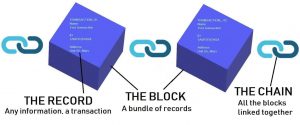
Blockchain technology is a decentralized and distributed ledger system that underlies most cryptocurrencies, including Bitcoin. It is a revolutionary and disruptive technology that has the potential to impact a wide range of industries beyond finance. At its core, a blockchain is a digital, tamper-proof record-keeping system that allows multiple parties to maintain a shared database without the need for a central authority.
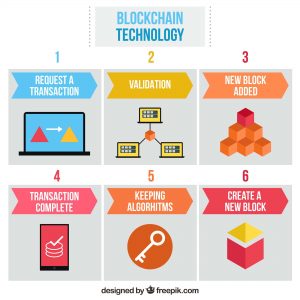
Here are some key aspects of blockchain technology:
-
Decentralization: Instead of relying on a central authority, such as a bank or government, a blockchain operates on a network of computers (nodes) that work together to validate and record transactions. This decentralization makes it resistant to censorship and control by any single entity.
-
Distributed Ledger: A blockchain is a distributed ledger that stores data across a network of nodes. Each node has a copy of the entire blockchain, and they work collectively to validate and record new transactions.
-
Immutability: Once data is added to a blockchain, it is extremely difficult to alter or delete. This immutability is achieved through cryptographic hashing and consensus mechanisms.
-
Transparency: Blockchain transactions are visible to all participants in the network. This transparency enhances trust and accountability, as anyone can audit the transaction history.
-
Security: Blockchain uses advanced cryptographic techniques to secure data. Transactions are grouped into blocks, and each block contains a reference to the previous block, creating a chain. This makes it very challenging for anyone to alter a transaction without changing all subsequent blocks.
-
Consensus Mechanisms: Blockchains rely on consensus mechanisms to agree on the validity of transactions. For example, Bitcoin uses Proof of Work (PoW), while other blockchains use different methods like Proof of Stake (PoS) or Delegated Proof of Stake (DPoS).
-
Smart Contracts: Smart contracts are self-executing contracts with the terms of the agreement directly written into code. They can automatically execute when predefined conditions are met.
-
Use Cases: Blockchain technology has applications beyond cryptocurrencies, including supply chain management, voting systems, identity verification, and healthcare records. It is often used to create trust in situations where intermediaries are traditionally required.
-
Challenges: Blockchain technology faces challenges such as scalability, energy consumption (for PoW-based blockchains), and regulatory issues. These challenges are actively being addressed by ongoing research and development efforts.
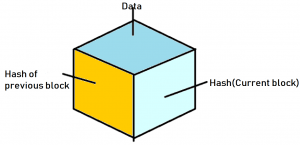
Types of blockchains
Currently, there are three types of blockchain networks – public blockchain, private blockchain and consortium blockchain.
- Public blockchain: A public blockchain has absolutely no access restrictions. Anyone with an internet connection can send transactions to it as well as become a validator. Some of the largest, most known public blockchain are Bitcoin and Ethereum.
- Private Blockchain: A private blockchain is permissioned. One cannot join it unless invited by the network administrators. Participant and validator access is restricted. This type of blockchain can be considered a middle-ground for companies that are interested in the blockchain technology in general but are not comfortable with a level of control offered by public networks. Typically, they seek to incorporate blockchain into their accounting and record-keeping procedures without sacrificing autonomy and running the risk of exposing sensitive data to the public internet.
- Consortium blockchain: A consortium blockchain is often said to be semi-decentralized. It, too, is permissioned but instead of a single organization controlling it, a number of companies might each operate a node on such a network. The administrators of a consortium chain restrict users’ reading rights as they see fit and only allow a limited set of trusted nodes to execute a consensus protocol.
Key terms in Blockchain world:
- Block is a piece of code that contains a list of transactions. The first block in the chain is called the genesis block.
- Blockchain is a constantly growing chain of blocks. The copies of the chain are stored on a number of computers (nodes) that partake in the network.
- Crypto currency is digital money with no physical equivalent.
- Bitcoin is a digital payment method and the most popular kind of crypto currency these days.
- Ethereum is the second most popular crypto currency with the large market capitalization (second only to Bitcoin).
- Fork is a change to the blockchain protocol that results in a chain split into two chains that will function independently.
- Mining is the process by which transactions are verified and added to the blockchain, and also the means through which new Bitcoin are released.
- Fee is the commission miners get for verifying a transaction and adding it to the blockchain.
- Faucets are websites that give away small portions of Bitcoin for free
- Smart contract are software modules on the blockchain that automatically execute transactions based on pre-defined conditions and business logic.
What is Blockchain Testing?
What is the need for testing in a Blockchain?
Blockchain applications are often associated with real-world assets and significant financial transactions. Any flaws or vulnerabilities in these applications can have severe consequences. Testing is crucial to prevent issues like smart contract vulnerabilities, data breaches, and unreliable performance.
A block once added to the blockchain remains there forever and if you try to change the data in some block in between the chain, the following blocks become invalid. A single change in block of the blockchain will cause every subsequent blocks to change as well. This makes it important that whenever a new block is added, it’s being added the right way because it cannot be changed at a later date. It becomes complex to exploit a blockchain and the testing of blockchain becomes even more complex.
Add to that, it’s contributes to large transactions which goes through validation, encryption, decryption, transmission so it becomes necessary to make sure that these processes go smoothly.
Setting Up Your Test Environment
Selecting the Right Blockchain Platform
Before you start testing, choose the appropriate blockchain platform for your project. Popular choices include Ethereum, Binance Smart Chain, or Polkadot. The choice depends on your project’s requirements.
Choosing the Appropriate Development Tools
Select the development tools and frameworks that best fit your platform. Tools like Truffle, Remix, or Solidity IDEs can help streamline smart contract testing and development.
Setting Up a Local Testnet
Set up a local blockchain network for testing using tools like Ganache or Geth. This allows you to conduct tests without incurring the cost associated with the mainnet.
What and how do we test in a Blockchain?
-
Smart Contract testing:
Smart Contracts are software modules on the blockchain that automatically execute transactions based on pre-defined conditions and business logic. Testing smart contracts involves simulation of all possible expected and unexpected conditions for every contract, testing all combinations of business logic and the proper triggering and correct execution of transactions.
1.1 Writing Test Cases
Develop comprehensive test cases that cover different scenarios. This should include unit tests, integration tests, and end-to-end tests to ensure the smart contracts operate correctly.1.2 Deploying Smart Contracts
Deploy your smart contracts to the test network, allowing you to interact with them as you would in a real environment.1.3 Testing for Security Vulnerabilities
Conduct thorough security testing to identify vulnerabilities such as reentrancy attacks, overflows, or permission issues.1.4 Functional Testing
Verify that your smart contracts function as intended, including transaction processing and data storage. -
Performance Testing
2.1 Understanding Performance Metrics
Identify key performance metrics, such as transaction throughput, confirmation times, and block propagation, to benchmark the performance of your blockchain application.
2.2 Load Testing
Simulate various loads to evaluate how your blockchain handles different transaction volumes. This helps in understanding the limits and bottlenecks of your system.
2.3 Stress Testing
Subject your blockchain to extreme conditions to test its resilience and behavior under duress. This can help uncover potential vulnerabilities. -
Security Testing
3.1 Vulnerability Assessment
Regularly scan for vulnerabilities using specialized tools and conduct code reviews to ensure that your codebase is secure.3.2 Penetration Testing
Employ ethical hackers to attempt to breach your system’s security, identifying weaknesses that need to be addressed.3.3 Code Review
Examine the smart contract code to ensure it adheres to best practices and security standards. -
Integration Testing
4.1 API Testing
Test the interactions of your blockchain application with other systems through APIs.4.2 Cross-Platform Compatibility
Ensure that your blockchain application can work seamlessly with various platforms and devices.4.3 Interoperability Testing
If your blockchain interacts with other blockchains or systems, verify that this integration works as intended. -
User Acceptance Testing
5.1 Creating User Scenarios
Invite actual users to interact with your blockchain application and gather feedback on the user experience.5.2 Feedback Gathering
Collect and analyze user feedback to make necessary improvements based on real-world usage. -
Block Size and Chain Size Testing:
Block Size refers to the maximum size of data that can be included in a single block, while Chain Size pertains to the cumulative size of the blockchain. Testing these aspects is essential to maintain efficiency and scalability.
6.1 Load Testing:
Create various scenarios to test how the network handles different block sizes. Incrementally increase the block size and observe network performance and confirmation times.6.2 Stress Testing:
Stress the blockchain with a high volume of transactions to assess how it handles an ever-growing chain. Measure synchronization times and resource consumption on nodes. -
Peer/Node Testing:
Testing the interaction between nodes (peers) is crucial to verify that the network is functioning correctly and securely.
7.1 Node Connectivity Testing: Check how well nodes can discover and connect to each other. Ensure nodes maintain consistent connections, even in the presence of network disruptions.
7.2 P2P Protocol Testing: Validate that the peer-to-peer communication protocol is correctly implemented and secure. Test for the ability to propagate new blocks and transactions among peers.
-
Cryptographic Data Testing:
Cryptographic integrity is fundamental to blockchain security. You should ensure that cryptographic data, such as signatures and hashes, is accurate.
8.1 Signature Verification: Verify that digital signatures on transactions and blocks can be correctly validated. Create test cases with both valid and invalid signatures.
8.2 Hash Function Testing: Ensure that the cryptographic hash functions used in the blockchain are resistant to collisions and pre-image attacks.
-
Consistency Testing:
Consistency in a blockchain refers to the uniformity of data across all nodes. Inconsistencies can indicate potential issues.
9.1 State Consistency Testing: Check whether the state of the blockchain is consistent among all nodes. Test for correct balances, contract storage, and execution results.
9.2 Fork and Reorganization Testing: Create scenarios that trigger forks and reorganizations in the chain. Ensure that the network can handle these situations and that consensus is maintained.
-
Data Corruption Testing:
Data corruption can lead to catastrophic failures in a blockchain. Testing for data integrity is crucial.
10.1 Data Corruption Scenarios: Inject corrupted data into the blockchain and observe how the network responds. Ensure that the blockchain can detect and reject corrupted blocks.
10.2 Data Recovery Testing: Test the ability of the network to recover from data corruption by using backups or other mechanisms.
Blockchain testing frameworks
There are several blockchain testing frameworks and tools available to help streamline the testing process for blockchain applications. These frameworks offer various features for testing different aspects of blockchain projects, including smart contracts, network performance, and security. Here are some popular blockchain testing frameworks:
-
Truffle:
Truffle is one of the most widely used blockchain testing frameworks for Ethereum-based projects. It provides a suite of tools for developing and testing Ethereum smart contracts. Truffle allows you to write comprehensive test cases using JavaScript and deploy them to the Ethereum test network or a local testnet. -
Ganache:
Ganache, part of the Truffle suite, is a personal blockchain emulator that makes local testing of Ethereum smart contracts easy. It provides a local testnet for quick development and testing, allowing you to simulate various network conditions and scenarios. -
Hardhat:
Hardhat is another Ethereum-focused development and testing framework. It offers a robust environment for developing, compiling, deploying, and testing smart contracts. Hardhat is known for its extensibility and developer-friendly features. -
Embark:
Embark is a framework for Ethereum decentralized applications (dApps) that includes a testing suite. It supports writing and running JavaScript and Solidity test cases and provides an integrated development environment for Ethereum development. -
Populus:
Populus is a Python-based development and testing framework for Ethereum smart contracts. It enables developers to write test cases using Python and is known for its simplicity and ease of use. -
Truffle Teams:
Truffle Teams is a cloud-based platform that offers continuous integration and continuous deployment (CI/CD) for Ethereum smart contracts. It provides an integrated testing environment and supports automated testing. -
Cypress:
While not blockchain-specific, Cypress is a popular end-to-end testing framework that can be used to test blockchain applications’ front-end interfaces. It offers features like automated browser testing, which can be valuable for dApps. -
Mocha and Chai:
Mocha is a widely used JavaScript testing framework, and Chai is an assertion library. Together, they can be used to write test cases for Ethereum smart contracts. They are versatile and can be used alongside other Ethereum testing tools. -
Ethers.js:
Ethers.js is a JavaScript library for interacting with Ethereum. It can be used to write test cases for smart contracts and interact with the Ethereum blockchain programmatically. -
Mythril and MythX:
Mythril is a security analysis tool for Ethereum smart contracts. MythX is a cloud-based service that integrates with Mythril to provide in-depth security analysis. These tools help identify vulnerabilities in smart contracts and can be integrated into your testing process.
A simple test strategy across the test phases
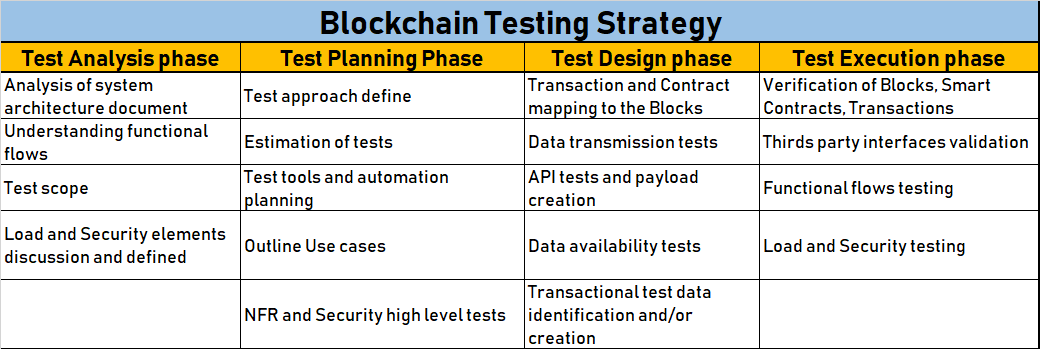
Recap
- Block chain is the technology on which Bitcoin is built on.
- Blockchain is a record of transactions, like a traditional ledger. These transactions can be any movement of money, goods or secure data—a purchase at a supermarket.
- Blockchain provides a solution to the existing issues of delay and dependency on one provider during a transaction through the validation mechanism called as Proof of block and decentralization of validating authority.
- Critical aspects to test in Blockchain are to test Block size, data size, Smart Contracting, Load, security and data transmission.
- Ethereum Tester, BitcoinJ and Populus are the main testing framework for Blockchain testing.
Afterthought
Since quality cannot be an afterthought, it needs to pro-actively built-in, practicing ‘value by design’ principles.
Blockchain testing is a critical phase in the development of any blockchain-based project.
While the overall testing process and test phases are same as testing any other application, there are some notable differences as Blockchain technology contains some peculiar and critical components.
Beginners should follow a structured approach, as outlined in this guide, to ensure that their blockchain applications are secure, performant, and reliable. Consistent testing and continuous improvement are key to success in the world of blockchain technology.

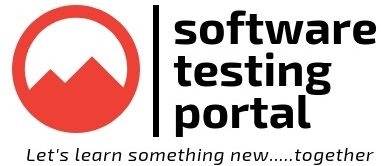

Great n thorough article on Block chain testing
Good one
Nice, detailed article.